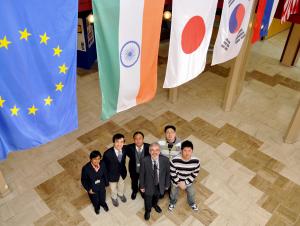Thirty-four and counting
15 Jul 2013
-
K.D.
The second group of Monaco Fellows stands below the ITER Member flags with David Campbell, head of the Plasma Operation Directorate.
It was foreseen by the authors of the ITER Agreement, which signed in 2006 by the seven ITER Members.
As a research organization, the ITER Organization may conclude scientific collaboration agreements with other international organizations and institutions in the interest of promoting cooperation on fusion as an energy source.
For ITER, collaboration agreements keep ITER scientists and engineers in close touch with work going on in precise domains relating to fusion science and technology; for the laboratories and institutes, they are an opportunity to collaborate with the fusion community's most advanced experiment.
Since January 2008, the ITER Organization has signed 34 scientific collaboration agreements and another four are currently in the preparatory stages. A common thread amongst these agreements is the training of young researchers.
"In the coming years, I envision more and more of this type of scientific exchange for the ITER Organization," says the Director-General of the ITER Organization, Osamu Motojima. "I would like to open ITER's door to younger people who will in fact take on a lot of the responsibility for fusion in the future. ITER will be the foremost research laboratory for magnetic fusion. Scientific collaboration agreements enrich the experience of our scientists, and provide training for the next generation of fusion scientists. The ITER Organization is a centre of excellence in this area."
Under these scientific collaboration agreements, the ITER Organization and research institutes can cooperate in academic and scientific fields of mutual interest. "Some of the ideas for collaboration come from our scientists. We have compiled a database of agreements signed by the ITER Organization so that when we're approached, we can inform them whether we already have an agreement with the institute in question," says Anna Tyler of Legal Affairs.
Typically, the agreements cover the following type of collaboration: joint supervision of students working on Masters or PhD theses; joint training and exchange of young scientists, engineers, interns and experts; joint research projects (particularly in plasma physics); and joint seminars.
Collaboration agreements have been signed with laboratories and institutes in Austria, China, France, Germany, India, Italy, Japan, Korea, Monaco, the Netherlands, Spain, Switzerland, Japan, and the UK—the most recent to date was signed just last month with the Department of Civil and Industrial Engineering at the University of Pisa (Italy).
David Campbell, head of ITER Plasma Operation Directorate, has been able to see the practical benefits of such exchanges. "Because we are aiming to develop ITER as centre of excellence in fusion research, such agreements allow us to develop scientific and technology exchanges with leading fusion research institutions around the world, building a network of fusion research activities which not only supports the preparations for ITER operation, but also contributes to the longer-term realization of the potential of fusion energy.
One of the more exciting aspects of the collboration agreements relates to the training activities and the opportunities they provide for younger researchers to participate in the ITER Project, according to Campbell. "The transfer of knowledge between generations is a key element of the scientific enterprise and an integral component of the development of ITER as an international centre of fusion research."


